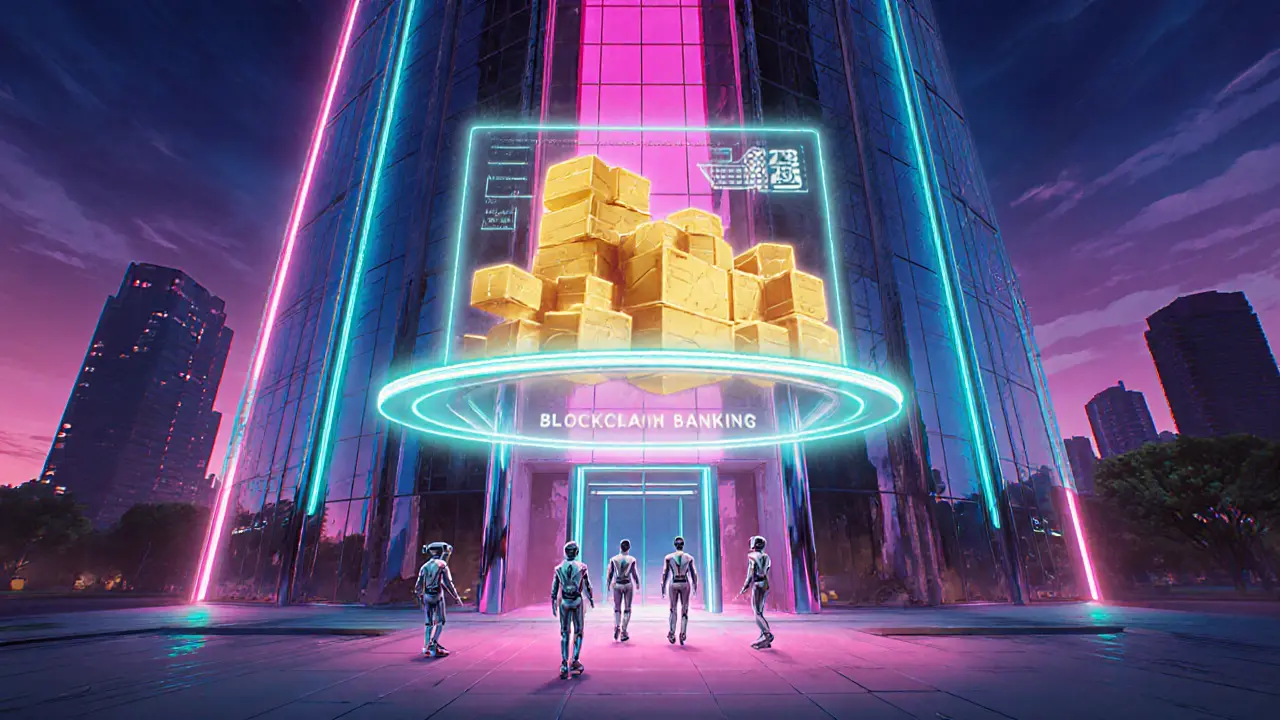Understanding Blockchain Banking Services: A Complete Guide
 Oct, 20 2025
Oct, 20 2025
Blockchain Banking Cost Calculator
Compare transaction costs between traditional banking and blockchain banking services to see potential savings.
Traditional Banking
Blockchain Banking
When banks talk about blockchain banking services, they’re referring to a set of financial solutions built on a distributed ledger that can cut costs, speed up transactions, and boost security.
What are Blockchain Banking Services?
Blockchain Banking Services are financial products and processes that use a decentralized digital ledger to record, verify, and settle transactions without relying on traditional intermediaries. The underlying technology-Blockchain-stores data in blocks linked together in an immutable chain, ensuring every entry is time‑stamped and tamper‑proof.
Core Applications in Modern Banks
Bankers have identified six primary use‑cases where the ledger shines:
- Smart contracts automate agreements by embedding business logic directly into code, eliminating manual checks and middlemen.
- Account‑to‑account payments-including B2B, B2C, and peer‑to‑peer transfers-are recorded instantly, reducing settlement windows from days to seconds.
- Cross‑border payments benefit from the ledger’s global reach, cutting out correspondent banks and slashing fees.
- Securities holdings can be tracked in real time, giving investors a clear view of ownership and provenance.
- Trade finance becomes a paper‑less, auditable process as letters of credit, bills of lading, and customs documents are stored on the chain.
- Asset tokenization turns physical assets-real estate, art, even private equity-into digital tokens that can be bought, sold, or fractionally owned.
Why It Beats Traditional Banking (A Quick Comparison)
| Metric | Traditional Banking | Blockchain Banking Services |
|---|---|---|
| Transaction speed | Hours to days (especially cross‑border) | Seconds to minutes - real‑time settlement |
| Cost per transaction | Multiple intermediary fees (SWIFT, correspondent banks) | Minimal network fees; no middlemen |
| Security | Centralized databases - higher breach risk | Immutable ledger + cryptographic signatures |
| Transparency | Siloed records, manual reconciliation | Shared, auditable view for all authorized parties |
| Regulatory complexity | Well‑established frameworks | Emerging regulations; compliance still evolving |

Challenges and Regulatory Hurdles
Despite the clear upside, banks still wrestle with three big obstacles:
- Regulatory uncertainty: Agencies like the U.S. Federal Reserve have yet to define clear rules for public‑chain assets, leaving banks cautious.
- Integration complexity: Legacy core banking systems don’t speak the same language as a ledger, so most institutions adopt a hybrid model-layering blockchain on top of existing infrastructure.
- Talent gap: Engineers and compliance officers need both finance and distributed‑ledger expertise, prompting costly up‑skilling programs.
Providers such as AWS Managed Blockchain and Hyperledger Fabric offer “Blockchain‑as‑a‑Service” (BaaS) platforms that let banks spin up private networks without building hardware from scratch.
Real‑World Examples
Several forward‑looking banks have already put the theory into practice:
- **Regions Bank** - Miles, a senior VP, says the bank cut its cross‑border processing time from 3‑5 days to under an hour after piloting a private ledger for USD‑to‑EUR transfers.
- **BankFrick** - Adam Retkes highlights how smart‑contract‑driven trade finance reduced document handling by 70 % and eliminated duplicate data entry.
- **Swiss cantonal banks** - Using tokenization, they now offer fractional ownership of luxury real‑estate, opening the market to investors with as little as $5 000.
These pilots share a common recipe: start small, integrate with existing core systems, and expand as regulatory clarity improves.

Future Outlook and Emerging Trends
Looking ahead to 2026 and beyond, three trends will shape the next wave of blockchain banking services:
- DeFi‑inspired banking products: Lenders are building permissioned lending pools that borrow the openness of DeFi while staying within AML/KYC frameworks.
- Hybrid multi‑cloud architectures: Banks will run private ledgers on‑premise for sensitive data while linking to public‑cloud BaaS for scalability.
- Standardized token frameworks: Initiatives like the ISO 20022‑based token standard will make it easier to exchange tokenized assets across borders.
When regulators finally codify digital‑asset rules, adoption will accelerate, turning today’s pilots into mainstream services for everything from salary payments to syndicated loan issuance.
Key Takeaways
- Blockchain banking services replace intermediaries with a shared, immutable ledger.
- Smart contracts, tokenization, and real‑time settlement are the biggest value drivers.
- Speed, cost, security, and transparency improve dramatically, but regulatory and integration challenges remain.
- Early adopters are seeing measurable savings and new revenue streams.
- The next few years will likely bring standardized tokens, hybrid cloud ledgers, and tighter regulatory frameworks.
What exactly is a blockchain banking service?
It is a financial product-such as a payment, a loan, or a securities settlement-built on a distributed ledger that records every step in a tamper‑proof way, removing the need for multiple middlemen.
How do smart contracts improve banking processes?
Smart contracts embed the terms of a deal into code. When conditions are met-say, a shipment is confirmed-the contract automatically triggers payment, cutting out manual verification and reducing error risk.
Can blockchain really make cross‑border payments instant?
Yes. By moving the transaction onto a shared ledger, banks bypass the correspondent‑bank network and settle directly with the counterpart, often within seconds to a few minutes.
What are the biggest regulatory concerns?
Regulators worry about anti‑money‑laundering (AML), know‑your‑customer (KYC) compliance, and the legal status of tokenized assets. Until clear guidelines emerge, banks adopt permissioned (private) ledgers to retain control.
Is blockchain banking only for large institutions?
No. Cloud‑based BaaS platforms let smaller credit unions and fintechs launch ledger‑based services without heavy upfront investment, leveling the playing field.
Marlie Ledesma
October 24, 2025 AT 02:21I love how this breaks down blockchain banking without making it sound like sci-fi. I work at a small credit union and we’ve been eyeing this for years-finally feels like the pieces are coming together.
My cousin in Kenya sends money home every month, and the fees used to eat up 12% of the transfer. If this actually cuts that down, it’s life-changing for families like hers.
Daisy Family
October 24, 2025 AT 11:46oMG so blockchain is just… fancy excel? 😴
they’re just calling it ‘decentralized’ so they can charge more for ‘tech consulting’ lmao
Paul Kotze
October 24, 2025 AT 15:10This is one of the clearest overviews I’ve seen. As someone in South Africa who’s seen how slow and expensive cross-border remittances are, this isn’t theoretical-it’s urgent.
Tokenized assets could let small farmers here sell shares of their land to diaspora investors. That’s real wealth-building. The tech’s ready. What’s missing is policy that doesn’t treat innovation like a threat.
Jason Roland
October 25, 2025 AT 14:14People are acting like blockchain banking is some magical fix, but let’s be real-it’s not replacing banks, it’s upgrading their plumbing.
Those legacy systems? They’re like Windows XP with duct tape. You can slap a blockchain API on top, but if your core can’t handle real-time data, you’re just adding a fancy dashboard to a broken engine.
Also-why are we still talking about ‘private ledgers’ like they’re the future? If it’s not transparent enough for regulators, it’s not blockchain. It’s just a fancy database with a buzzword label.
Niki Burandt
October 26, 2025 AT 13:39Okay but have you seen the energy usage?? 💀
Like… we’re trading bank fees for carbon footprints? And ‘tokenized real estate’? So now your $5k investment is just a digital receipt that can vanish if the platform shuts down? 😅
Also, ‘permissioned blockchain’ is just corporate blockchain. Don’t pretend it’s revolutionary when it’s just a walled garden with a blockchain sticker on it.
Chris Pratt
October 27, 2025 AT 04:16Love how this highlights real examples-not just hype. I’ve seen similar pilots in rural communities in the U.S. where fintechs partnered with local banks to offer microloans via smart contracts.
It’s not flashy, but it works. People get loans in 2 hours instead of 2 weeks. That’s the real win.
Karen Donahue
October 27, 2025 AT 15:06Let me get this straight-you’re telling me we’re going to trust a system that can’t even be properly regulated, that’s built by people who barely understand finance, and that’s being sold to the public while the banks quietly keep their old systems running in the background? And you think this is progress?
It’s not innovation-it’s a distraction. A shiny object to keep people from asking why their bank still charges $35 for an overdraft while ‘cutting costs’ with blockchain. The whole thing smells like a tech bro fantasy dressed up as financial reform.
And don’t even get me started on ‘fractional ownership’-so now rich people can buy pieces of a mansion and pretend they’re investors? Meanwhile, my rent went up 20% this year. Thanks, blockchain.
Bert Martin
October 27, 2025 AT 15:33Great breakdown. I’ve coached a few fintech startups through this exact transition.
Key tip: Don’t try to boil the ocean. Start with one payment corridor. One smart contract use case. One pilot. Measure the savings. Then scale.
Most failures happen because they want to replace everything at once. The winners? They just made one thing faster, cheaper, and more transparent. That’s all you need to start.
Ray Dalton
October 28, 2025 AT 14:13Ray here-worked with AWS Managed Blockchain for a regional bank last year. The hybrid model works. We kept customer data on-prem, used cloud BaaS for settlement. Cut reconciliation time from 4 days to 3 hours.
Biggest win? Compliance officers stopped screaming. Audit logs were automatic. No more PDFs in shared drives.
Peter Brask
October 28, 2025 AT 19:44Blockchain banking? More like BANKING FOR THE NEW WORLD ORDER. 🕵️♂️
They’re laying the groundwork for digital ID tracking, asset confiscation, and cashless control. You think your $5k real estate token is safe? Wait till the Fed decides to freeze ‘high-risk’ assets.
Remember when they said ‘cashless society’ was conspiracy? Now it’s a Bloomberg headline.
They’re not fixing banking-they’re replacing it with a surveillance tool. And you’re clapping? 😒
Trent Mercer
October 29, 2025 AT 10:58‘Tokenization opens real estate to $5k investors’? Cute.
That’s not democratization-that’s financialized speculation wrapped in blockchain glitter. The same people who own 80% of the market will still own 80% of the tokens.
And ‘ISO 20022 standard’? That’s just Wall Street’s way of saying ‘we’re gonna own the protocol too.’
Kyle Waitkunas
October 30, 2025 AT 03:00THIS IS THE BEGINNING OF THE END. 😱
They’re not just replacing banks-they’re replacing CASH. And once cash is gone, they can track every. single. purchase. Every. coffee. Every. bus ride. Every. donation to a protest. You think your ‘tokenized’ assets are safe? What if the government decides your ‘risk profile’ is too high?
They’ve been preparing for this for DECADES. The ‘pilots’? They’re rehearsals. The ‘regulatory clarity’? It’s coming. And when it does, you won’t be able to opt out.
Wake up. This isn’t innovation. It’s digital serfdom. And you’re all cheering for your own chains.
They’re coming for your money. And your freedom. And you’re reading about ‘smart contracts’ like it’s a TED Talk. 😭